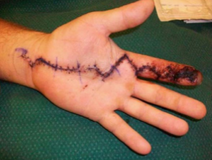High-pressure fluid injection injuries usually occur when fluid under pressure (usually 2,000 to 6,000 psi or more), whether the equipment is running or not, punctures the fingers or hand usually due to a leak. The injury may not be immediately noticeable because the size of the entrance wound can be as small as a pin head or entry can occur through an existing injury.
Once inside your body, this caustic fluid will cause tissue to die quickly, creating a situation where bacterial infections may cause gangrene. The fluid will also travel, causing tissue in the hand and arm to be affected.
The Fluid Power Safety Institute’s copyrighted “Pressurized-System Safety” publication provides recommended best practices for investigating and repairing hydraulic leaks in flexible hose, steel tubing and steel piping.
Most equipment manufacturer’s manuals state that escaping fluid can cause severe internal injuries but often do not include procedures on how to dissipate - and verify - de-pressurization of hydraulic systems.


 RSS Feed
RSS Feed
